.avif)
.avif)
Most e-commerce stores invest heavily in attracting new customers, only to lose them after a single purchase. According to Paytronix and Merkle, brands that use challenges or digital games experience a 35% rise in repeat visits, showing that customers respond better when loyalty feels enjoyable instead of transactional.
What if your loyalty program didn’t just hand out discounts but invited customers to play, earn, and celebrate along the way? What if your shoppers returned not for the coupon, but for the sense of progress and achievement?
That is the essence of loyalty gaming; turning rewards into interactive experiences that build genuine connections and lasting habits.
In this blog, you will explore 10+ loyalty program gamification ideas and strategies to help your e-commerce brand boost engagement, increase repeat sales, and build a community of returning customers who love interacting with your store.
What You’ll Learn in This Guide
- Loyalty gaming transforms repeat purchases into interactive experiences that build habit, motivation, and emotional connection with your brand.
- Game mechanics like progress tracking, badges, and streaks turn routine actions into measurable engagement opportunities for e-commerce stores.
- Personalized challenges and surprise rewards keep loyalty programs dynamic, ensuring customers return for the experience, not just the discount.
- Data from loyalty gaming helps you refine offers, segment audiences, and deliver more relevant rewards through automation and analytics.
- With platforms like Nector, you can build scalable loyalty gaming systems that require minimal manual effort and deliver long-term retention.
What Is Loyalty Gaming and Why It Works for E-Commerce
Loyalty gaming adds game mechanics to your loyalty program to make earning and redeeming rewards engaging. It links customer actions such as purchases, referrals, or reviews with features like points, levels, badges, and challenges. This turns loyalty into an active experience that motivates shoppers to keep participating.
The Core Idea Behind Loyalty Gaming
Loyalty gaming converts routine interactions into achievements. Instead of passively collecting points, customers track their progress and see tangible results. This visible progress keeps them involved and encourages repeat engagement.
You can build loyalty gaming into your store using tools like Nector, which includes tier-based rewards, progress bars, and automated challenges that adjust to customer behavior.
Key game mechanics that drive engagement include:
- Progress Tracking: Milestones such as bars or badges show how close customers are to earning rewards.
- Instant Feedback: Immediate acknowledgment after earning points increases satisfaction.
- Variable Rewards: Randomized or surprise incentives keep users interested.
- Social Recognition: Leaderboards or mentions reward community participation.
Why Loyalty Gaming Resonates with Shoppers
Loyalty gaming works because it appeals to three main motivators that shape human behavior. These motivators influence how customers respond to challenges and rewards.
The table below breaks down these motivators and their practical applications in loyalty programs.
Research by the Wharton NeuroLeadership Institute (2024) found that gamification improves productivity by 15% by enhancing motivation through autonomy, mastery, and achievement. In e-commerce, these same triggers increase engagement, purchase frequency, and customer loyalty.
Once you understand the core mechanics, it’s important to look at the psychological triggers that make loyalty gaming work.

The Psychology Behind Loyalty Gaming
Loyalty gaming works because it triggers specific behavioral responses that keep customers engaged. When you design a program that rewards progress, status, and anticipation, customers experience measurable satisfaction each time they interact with your brand. This sense of achievement builds stronger emotional connections and encourages repeat actions like purchases, referrals, and reviews.
Key Behavioral Triggers That Drive Engagement
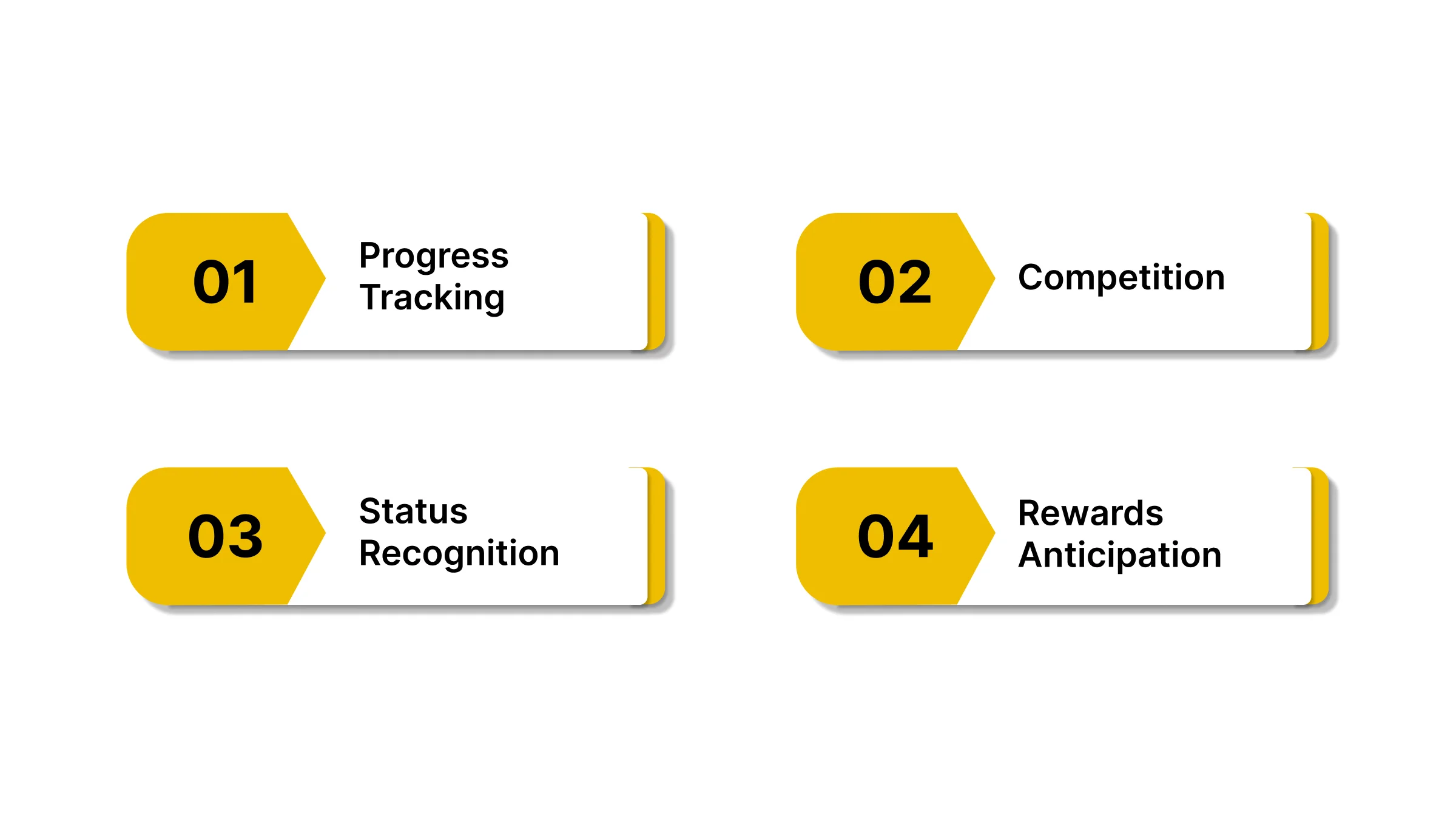
The success of loyalty gaming depends on understanding what keeps users motivated to return. The following triggers activate reward centers in the brain and help you create a loyalty experience that feels both fun and rewarding.
- Progress Tracking: Customers stay invested when they can see how far they’ve come. A visible progress bar or milestone tracker makes each interaction feel meaningful. For example, customers who earn points for every purchase and see how close they are to their next tier are more likely to complete another order.
- Competition: Friendly competition encourages continuous participation. Introducing small leaderboards or seasonal contests pushes customers to stay active and engaged. You can use tools like Nector to create these challenges automatically and track engagement in real time.
- Status Recognition: People value recognition for their loyalty. Displaying tier badges or exclusive titles, such as “Gold Member” or “Top Reviewer,” validates their effort. Public recognition through personalized messages or email campaigns increases emotional attachment to the brand.
- Rewards Anticipation: Anticipating a reward can be as satisfying as receiving it. Giving customers small tasks or streak challenges, such as “Shop twice this month to earn bonus points,” keeps them motivated. The consistent expectation of rewards turns engagement into habit.
Applying Psychology to Strengthen Loyalty
The behavioral principles behind loyalty gaming align with intrinsic motivation—the internal desire to achieve progress and be recognized. When you apply these principles, your loyalty program becomes more than a marketing tool; it becomes an ongoing experience that customers actively want to engage in.
You can combine these triggers into one cohesive system using automation tools like Nector, which helps structure progress tracking, reward timing, and personalized recognition without requiring manual setup.
Also Read: 9 Successful Loyalty Program Examples to learn from in 2025
Knowing the psychology behind loyalty helps you apply it practically through proven strategies and gamified program ideas.
10+ Loyalty Gaming Ideas and Strategies to Try
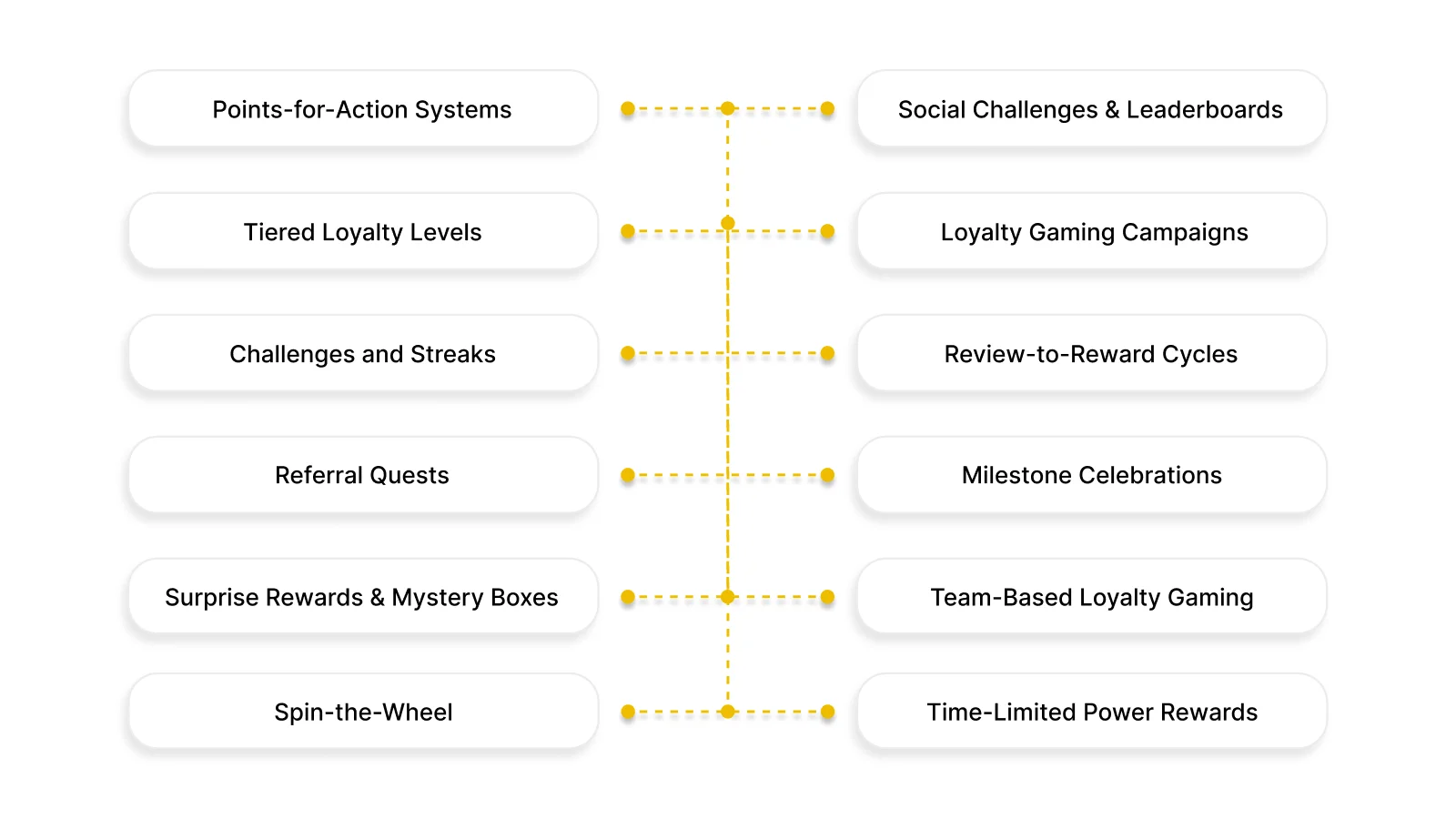
This is where you turn theory into action. The following loyalty gaming strategies show how you can design reward systems that keep customers engaged, encourage repeat purchases, and make participation feel fun. Each idea works well for Shopify or WooCommerce stores and can be automated using tools like Nector.
Below are 12 practical loyalty gaming ideas and strategies you can implement right away to make your rewards program more interactive, measurable, and effective.
1. Points-for-Action Systems
Rewarding small, consistent actions keeps engagement steady. You can assign points for signups, reviews, referrals, or social shares. When customers see that every interaction earns value, they return more often.
Examples:
- A beauty brand gives 20 points for following its Instagram page.
- A wellness store awards 50 points for submitting a product review.
- Automation in Nector ensures points are tracked and applied instantly after each action.
From one-time buyers to lifelong customers. Transform your retention strategy with Nector’s Loyalty Solution: create gamified rewards that keep shoppers engaged, motivated, and coming back!
2. Tiered Loyalty Levels
Tiered systems encourage ongoing participation by giving shoppers visible goals to work toward. When you show progress bars or badges, customers feel rewarded at every step.
Each level can unlock specific perks such as free shipping, early access, or limited-edition gifts. Tools like Nector automate upgrades based on purchase history, keeping progress seamless.
3. Challenges and Streaks
Short-term challenges drive urgency and repeat visits. When you give customers tasks such as “Shop three times this month” or “Review two products this week,” you turn engagement into an ongoing habit.
Example Ideas:
- A fashion store runs a “Weekend Style Challenge” where customers earn double points for purchases made within 48 hours.
- A wellness brand rewards users who complete a three-purchase streak with bonus points.
Challenges can be tracked visually within your loyalty dashboard, motivating users to complete their goals.
4. Referral Quests
Referrals become more engaging when presented as missions. Assign goals such as “Refer three friends this month” or “Hit five successful invites to reach Silver status.” Both the referrer and the friend receive rewards, creating a loop of shared incentives.
Effective Approaches:
- A skincare store offers 100 bonus points when a referred friend completes their first purchase.
- A home decor brand provides an additional 10% discount after five successful referrals.
- Referral tracking in Nector ensures transparency and prevents duplicate or fraudulent entries.
This strategy converts your loyal customers into active brand advocates.
From high ad costs to high-quality referrals. Transform your growth strategy with Nector’s Referral Solution, built to turn satisfied customers into powerful brand advocates who drive measurable growth.
5. Surprise Rewards and Mystery Boxes
Unexpected rewards maintain excitement and strengthen retention. Offering surprise bonuses or mystery boxes at random intervals keeps customers curious and increases participation in loyalty programs.
Implementation Examples:
- A beauty brand sends a mystery reward email once customers hit 500 points.
- A wellness store gives random “spin-the-wheel” discounts to frequent shoppers.
- Data from Shopify’s reward engagement reports show that surprise incentives can increase click-through rates by up to 25%.
Surprises create emotional value, making your customers feel recognized beyond regular transactions.
6. Spin-the-Wheel or Scratch Cards
Adding an element of chance creates anticipation during checkout. Spin-the-wheel or scratch card games let customers win instant rewards such as discounts, bonus points, or free gifts. When implemented responsibly, these mini-games increase average order value (AOV) without making customers feel pressured.
Implementation Tips:
- Offer limited spins per day or week to maintain fairness.
- Provide rewards in small, achievable ranges such as 5%, 10%, or 15% off.
- Use platforms like Nector to automate reward distribution and prevent duplicate participation.
- Display results instantly to keep excitement high and participation consistent.
7. Social Challenges and Leaderboards
Social challenges drive engagement by appealing to your customers’ competitive nature. Creating simple contests like “Top Reviewer of the Month” or “Most Shares This Week” motivates participants to interact more often and share their achievements.
Examples You Can Try:
- A fashion brand ranks customers by monthly photo submissions wearing its products.
- A skincare company rewards top contributors who post and tag reviews on Instagram.
- Use leaderboards within your loyalty portal to display real-time rankings and boost visibility.
Leaderboards build community recognition and turn engagement into social proof, encouraging organic advocacy.
8. Story-Driven Loyalty Gaming Campaigns
Seasonal storytelling adds freshness to loyalty programs. You can theme challenges around holidays or product launches, giving customers a narrative to follow. This approach ties promotions, rewards, and community events into one unified experience.
Practical Ways to Apply This:
- Run a “Winter Quest” where shoppers complete small missions like “Buy two winter essentials” or “Leave a review on your favorite cozy product.”
- Integrate the campaign across email, WhatsApp, and social media to maintain continuity.
- Nector’s automation tools can schedule these missions and track completion seamlessly.
Story-driven campaigns help you connect emotionally with customers and keep your program dynamic throughout the year.
9. Review-to-Reward Cycles
Reviews play a major role in building trust. Rewarding customers for sharing honest feedback motivates participation and creates authentic social proof. You can automate these cycles to ensure continuous engagement without manual follow-ups.
Execution Ideas:
- Reward customers with points or coupons for verified product reviews.
- Integrate with platforms like Judge.me or Google Reviews to collect and display reviews automatically.
- Offer bonus points for photo or video submissions to encourage detailed content.
This strategy generates user-generated content while reinforcing loyalty with every review.
10. Milestone Celebrations (Birthdays, Anniversaries, First Orders)
Recognizing personal milestones strengthens emotional connection. Sending a personalized message or reward during key customer dates shows that your brand values individual relationships.
Ways to Apply This:
- Offer double points on birthdays or customer anniversaries.
- Send free samples or small gifts after the first or fifth purchase.
- Automate reminder emails using tools like Nector to ensure timely celebrations.
These gestures turn transactional relationships into emotional ones, encouraging repeat purchases through personalized appreciation.
Also Read: Boost Post-Purchase Loyalty Strategies
11. Collaborative or Team-Based Loyalty Gaming
Team-based loyalty models encourage group participation and are ideal for lifestyle or subscription brands with community-driven audiences. Customers work together toward shared goals, such as total referrals or cumulative purchases, to unlock rewards for the group.
Setup Ideas:
- A fitness brand forms “member squads” that collectively earn points for completing wellness challenges.
- A subscription box brand creates “referral circles” where groups unlock discounts after reaching shared milestones.
- Nector’s referral tracking tools can assign shared points automatically across team members.
Team-based systems combine cooperation and shared motivation, turning your customers into community advocates while keeping engagement strong.
12. Time-Limited Power Rewards
Time-limited rewards create urgency and drive quick action. These are short-duration incentives that expire within hours or days, prompting customers to engage immediately. The temporary availability makes rewards feel exclusive and valuable, leading to higher participation rates and faster conversions.
Execution Ideas:
- Offer a “24-Hour Power Bonus” where shoppers earn double points for purchases made within a set timeframe.
- Send targeted notifications through email or WhatsApp reminding customers about the countdown.
- Combine this strategy with seasonal sales or product launches to maximize engagement.
- Use automation tools like Nector to schedule and expire these bonuses automatically, ensuring consistency and fairness.
Time-limited power rewards maintain excitement, prevent stagnation in loyalty programs, and give customers regular reasons to return to your store. These strategies do more than drive engagement—they directly impact retention and increase customer lifetime value over time.

How Loyalty Gaming Enhances Retention and LTV
Loyalty gaming increases customer retention by making every interaction purposeful and rewarding. When your customers engage with challenges, tiers, or missions, they form habits that keep them connected to your brand over time. This consistent engagement directly improves Customer Lifetime Value (LTV) because shoppers not only buy more often but also spend more with each visit.
Correlation Between Engagement and Lifetime Value
Customers who participate in gamified loyalty programs interact with your store more frequently. Each action, such as earning points or reaching a tier, builds commitment and strengthens emotional ties.
Direct impact of gamified loyalty on retention and LTV:
- Higher Repeat Purchases: Customers are motivated to complete challenges, unlocking rewards faster and returning sooner.
- Increased Average Order Value: Earning progress toward the next reward encourages customers to add more to their carts.
- Reduced Churn Rate: Personalized achievements and badges make customers feel recognized, reducing drop-offs after initial purchases.
Better Data for Personalization
Loyalty gaming programs naturally collect behavioral data that helps you understand how customers interact with your store. You can track which actions are most frequent, which rewards drive redemptions, and which customers are most loyal. This data allows you to personalize experiences and deliver rewards that align with individual motivations.
Tools like Nector simplify this data tracking by integrating analytics into your loyalty dashboard, helping you segment audiences automatically and trigger personalized notifications.
Also Read: Unleashing the Power of Customer Loyalty Programs - Top 10 Examples
Using Analytics to Refine Reward Strategy
Analytics transform loyalty gaming from a static setup into a dynamic retention system. By examining customer activity patterns, you can identify which reward types drive engagement and where participation drops off.
Practical ways to refine your loyalty strategy using analytics:
- Monitor redemption rates to assess whether rewards feel achievable.
- Test reward values and frequency to find the optimal balance between effort and motivation.
- Identify underperforming segments and introduce targeted missions to re-engage them.
- Evaluate which challenges contribute most to repeat purchases and replicate successful formats.
Platforms like Nector combine loyalty analytics with automation, so you can adjust campaigns in real time without manual intervention. Over time, this continuous feedback loop strengthens retention, improves program efficiency, and increases overall customer lifetime value.
Case Study: R for Rabbit – Building Repeat Purchases Through Loyalty Gaming
A leading baby care brand, R for Rabbit, used Nector’s loyalty and referral systems to strengthen customer retention and encourage repeat sales. By rewarding everyday actions and referrals, the brand turned parents into active participants in their shopping experience.
How They Achieved It:
- Used Nector’s Loyalty Widget to reward signups and repeat orders with coins and cashback.
- Launched a Referral Program offering ₹200 cashback to referrers and ₹200 discounts to new customers.
- Integrated across Shopify and CRM tools for seamless tracking and automation.
This case demonstrates how loyalty gaming can convert transactional buyers into loyal advocates when implemented with the right strategy.
Use Nector to gamify loyalty, referrals, and reviews in one dashboard: just like R for Rabbit. Get started now and see repeat purchases rise from day one.
As your program matures, keeping it fresh and engaging becomes essential to maintain long-term participation and results.
Tips to Keep Your Loyalty Gaming Program Engaging Long-Term

A loyalty gaming program needs regular updates and balance to keep customers active. If your program feels repetitive or overly simple, engagement will decline. The key is to maintain freshness and challenge without overwhelming users. The following practical actions help you sustain participation and improve results over time.
- Refresh Challenges Monthly:
Rotate your challenges and streak missions each month to maintain excitement. For example, introduce a “Weekend Rewards Challenge” or a “Holiday Bonus Hunt.” Platforms like Nector allow you to schedule these updates automatically so your team doesn’t need to rebuild campaigns manually. - Test Reward Types and Point Values:
Experiment with discounts, free gifts, or exclusive access to identify which incentives your customers value most. Reviewing redemption analytics helps you find the right balance between reward cost and customer motivation. - Celebrate Top Customers Publicly:
Showcase high performers through emails, leaderboards, or social mentions. Recognizing loyal participants builds a sense of pride and encourages others to engage more often. - Monitor Participation Drop-Offs and Adjust Rewards:
Track engagement metrics like challenge completions and referral rates to detect where interest declines. Adjust your tasks or reward thresholds to keep participation steady. - Balance Effort and Reward:
Make your challenges attainable but not effortless. Customers should feel that each achievement requires consistent engagement. Properly balanced difficulty ensures that progress feels rewarding and keeps them returning.
These steps keep your loyalty gaming program relevant and effective over time, helping you sustain long-term engagement while continuing to grow customer loyalty. Sustaining engagement also means avoiding common mistakes that reduce clarity, motivation, and overall program performance.
Common Mistakes to Avoid in Loyalty Gaming

Even well-designed loyalty gaming programs can lose effectiveness if they are not structured carefully. Avoiding common mistakes helps you maintain clarity, fairness, and engagement. The following pitfalls are the most frequent causes of declining participation and lower retention.
- Overcomplicating Point Systems:
When earning rules are unclear or involve too many variables, customers lose interest. Keep point systems simple and transparent, such as “1 point for every $1 spent.” Use tools like Nector to automate calculations and display balances clearly within your loyalty dashboard. - Ignoring Data on Customer Engagement:
Failing to analyze participation metrics leads to stagnant programs. Track engagement rates, redemption trends, and tier progress regularly. Reviewing analytics helps you identify which rewards or challenges work best and which need refinement. - Offering Rewards Misaligned with Customer Motivation:
Generic or irrelevant rewards reduce program value. Ensure your incentives match customer preferences—offer beauty samples for skincare brands or early product access for fashion shoppers. Personalized rewards maintain excitement and strengthen loyalty.
A loyalty gaming program works best when it stays simple, data-informed, and personalized. Simplicity and personalization together create sustained engagement and long-term customer loyalty.
After understanding what works and what doesn’t, you can put these insights into action with Nector’s loyalty gaming tools.
How to Apply Loyalty Gaming Using Nector?
You can apply every loyalty gaming strategy discussed so far through Nector, a platform built to help e-commerce brands design and automate reward programs without complexity. Instead of handling multiple tools or manual tracking, Nector lets you set up loyalty systems that run smoothly in the background while keeping customers consistently engaged.
Here is how you can put these strategies into action using Nector:
- Gamified Loyalty:
Create points-based, tiered, and challenge-driven programs that reward every purchase, referral, or review. You can customize reward values, set earning rules, and display visual progress indicators such as progress bars or badges to motivate continuous engagement. - Referral Quests:
Encourage customers to invite friends through pre-built referral missions. Nector allows sharing via WhatsApp, SMS, or email, ensuring that both referrers and referees receive rewards instantly. Fraud detection features maintain trust and accuracy. - Review Rewards:
Automate feedback collection by rewarding customers for leaving reviews or ratings. Integrations with Judge.me and Google Reviews make it simple to gather authentic testimonials while increasing engagement. - Seamless Integrations:
Connect Nector with Shopify, Klaviyo, Mailchimp, and WhatsApp to unify your marketing and retention workflows. This ensures that reward triggers, notifications, and campaigns stay consistent across all platforms. - Analytics Dashboard:
Access a centralized view of customer interactions, redemption rates, and participation trends. These insights help you adjust challenges, refine incentives, and identify your most loyal customers.
Nector simplifies loyalty gaming for small e-commerce teams, founder-led stores, and agencies managing multiple brands. You can build scalable programs that look professional and feel personal without requiring large teams or technical expertise.
Conclusion
Loyalty gaming turns shopping from a simple transaction into a consistent and enjoyable experience. When customers track their progress, anticipate rewards, and celebrate milestones, they begin to associate your store with excitement and satisfaction. Every completed challenge or earned badge strengthens their connection and keeps them coming back willingly.
Start small by gamifying one customer interaction such as rewarding a product review, creating a referral quest, or setting a weekend challenge. Once customers enjoy the process of earning rewards, they will naturally stay engaged. Consistent participation builds a pattern that leads to long-term loyalty and repeat sales.
The most effective e-commerce brands go beyond discounts to create moments that customers look forward to. Loyalty gaming helps you do that by making engagement rewarding and fun.
If you want customers who come back because they enjoy every interaction, Nector makes it simple to build loyalty gaming that works. Start your demo and see the difference from day one.
FAQs
Q: How can loyalty gaming improve customer engagement for small e-commerce teams?
A: Loyalty gaming automates engagement through challenges, points, and rewards. It helps small teams maintain consistent customer interaction without manual effort.
Q: What’s the best way to measure the success of a loyalty gaming program?
A: Track metrics like repeat purchase rate, average order value, and redemption frequency. Use analytics from platforms like Nector for precision.
Q: How often should you update or refresh loyalty gaming challenges?
A: Refresh challenges monthly to keep excitement high. Rotating rewards and themes maintains interest and avoids customer fatigue over time.
Q: Can loyalty gaming be integrated with existing email or CRM systems?
A: Yes, tools like Nector integrate with Shopify, Klaviyo, and Mailchimp, enabling seamless automation of campaigns and loyalty communication.
Q: How do you keep loyalty gaming fair without making it too easy?
A: Set clear, attainable milestones and balanced reward values. Ensure rewards feel earned to sustain motivation and long-term engagement.
Q: What industries benefit most from loyalty gaming strategies?
A: Fashion, beauty, and wellness brands benefit the most. These industries rely on emotional engagement and repeat purchases for growth.
FAQs
Start Building Customer Retention That Lasts


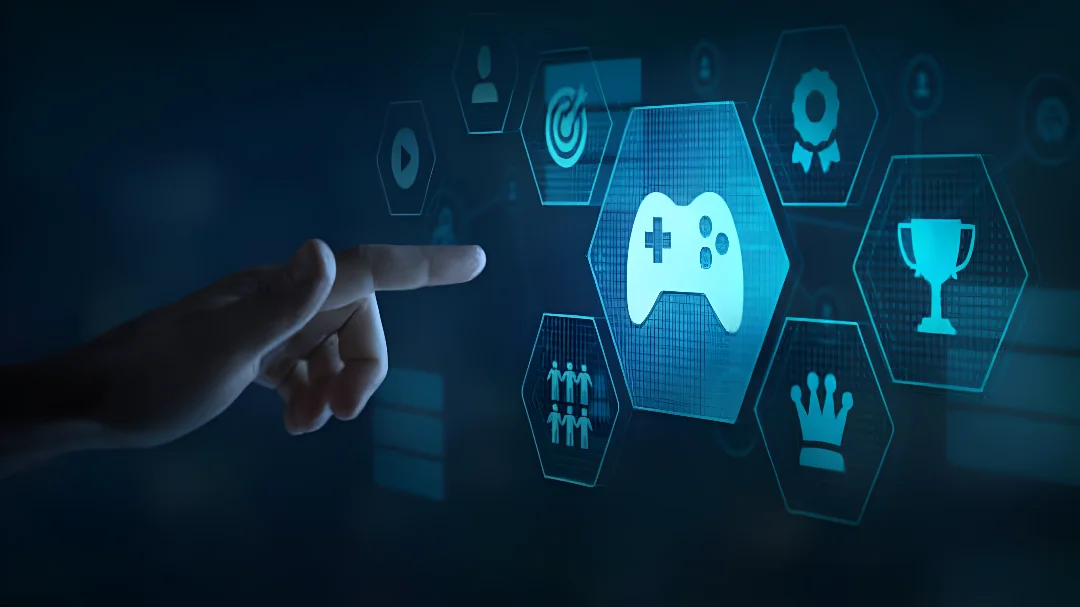

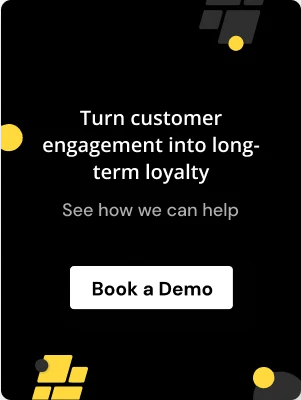
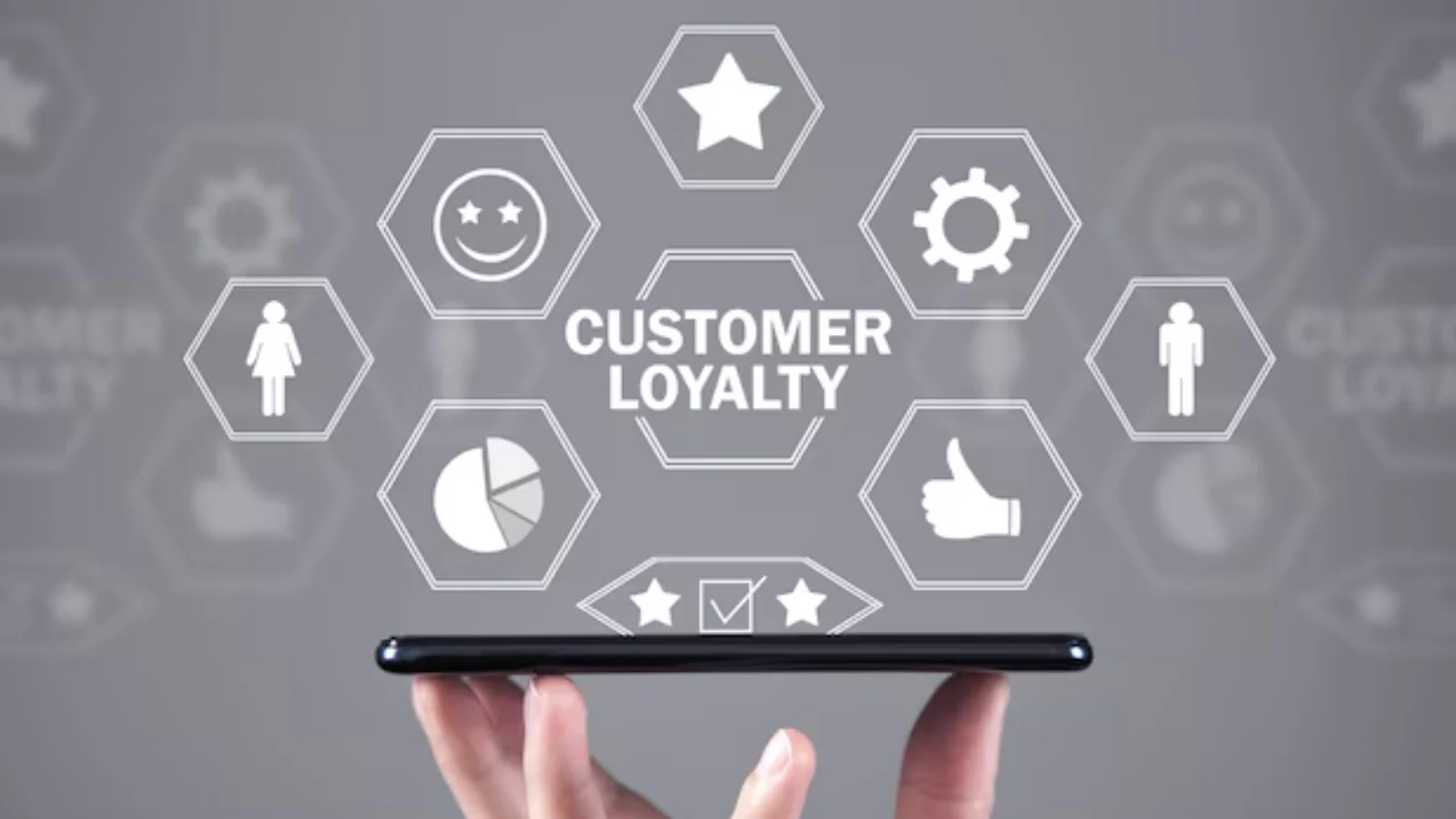
%201.webp)
%201.webp)

